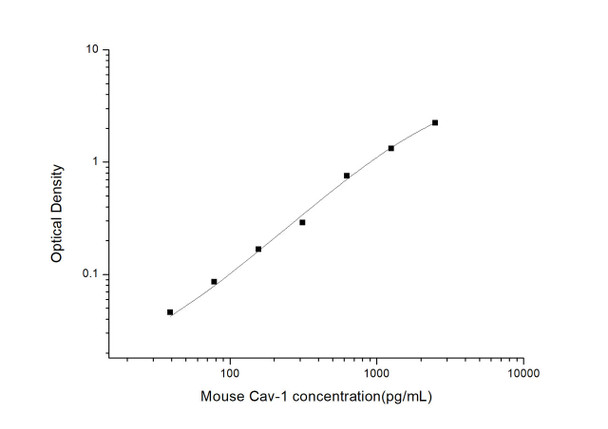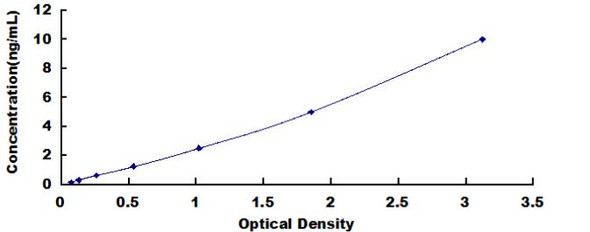Mouse CAV1 (Caveolin 1) ELISA kit (MOES00823)
- SKU:
- MOES00823
- Product Type:
- ELISA Kit
- Size:
- 96 Assays
- Uniprot:
- P49817
- Sensitivity:
- 23.44pg/mL
- Range:
- 39.06-2500pg/mL
- ELISA Type:
- Sandwich
- Synonyms:
- BSCL3, CGL3, MSTP085, VIP21
- Reactivity:
- Mouse
- Sample Type:
- Serum, plasma and other biological fluids
Description
Mouse CAV1 (Caveolin 1) ELISA kit
The Mouse CAV1 (Caveolin-1) ELISA Kit is specifically designed for the precise measurement of Caveolin-1 levels in mouse serum, plasma, and cell culture supernatants. This kit offers exceptional sensitivity and specificity, guaranteeing accurate and reproducible results, making it perfect for a variety of research applications.Caveolin-1 is a vital protein involved in cell signaling, lipid regulation, and vesicular trafficking.
It plays a critical role in various cellular processes and is implicated in diseases such as cancer, cardiovascular disorders, and neurological diseases. As a key biomarker, studying Caveolin-1 levels can provide valuable insights into these conditions and aid in the development of potential treatments.For more information, visit www.assaygenie.com/mouse-cav1-caveolin-1-elisa-kit-moes00823/
| Assay type: | Sandwich |
| Format: | 96T |
| Assay time: | 4.5h |
| Reactivity: | Mouse |
| Detection Method: | Colormetric |
| Detection Range: | 39.06-2500 pg/mL |
| Sensitivity: | 23.44 pg/mL |
| Sample Volume Required Per Well: | 100µL |
| Sample Type: | Serum, plasma and other biological fluids |
| Specificity: | This kit recognizes Mouse CAV1 in samples. No significant cross-reactivity or interference between Mouse CAV1 and analogues was observed. |
This ELISA kit uses Sandwich-ELISA as the method. The micro ELISA plate provided in this kit has been pre-coated with an antibody specific to Mouse CAV1. Standards or samples are added to the appropriate micro ELISA plate wells and combined with the specific antibody. Then a biotinylated detection antibody specific for Mouse CAV1 and Avidin-Horseradish Peroxidase (HRP) conjugate are added to each micro plate well successively and incubated. Free components are washed away. The substrate solution is added to each well. Only those wells that contain Mouse CAV1, biotinylated detection antibody and Avidin-HRP conjugate will appear blue in color. The enzyme-substrate reaction is terminated by adding Stop Solution and the color turns yellow. The optical density (OD) is measured spectrophotometrically at a wavelength of 450 nm ± 2 nm. The OD value is proportional to the concentration of Mouse CAV1. The concentration of Mouse CAV1 in samples can be calculated by comparing the OD of the samples to the standard curve.
| UniProt Protein Function: | Involved in the costimulatory signal essential for T-cell receptor (TCR)-mediated T-cell activation. Its binding to DPP4 induces T-cell proliferation and NF-kappa-B activation in a T-cell receptor/CD3-dependent manner. May act as a scaffolding protein within caveolar membranes. Interacts directly with G-protein alpha subunits and can functionally regulate their activity. Forms a stable heterooligomeric complex with CAV2 that targets to lipid rafts and drives caveolae formation. Recruits CTNNB1 to caveolar membranes and may regulate CTNNB1-mediated signaling through the Wnt pathway (PubMed:10816572). Negatively regulates TGFB1-mediated activation of SMAD2/3 by mediating the internalization of TGFBR1 from membrane rafts leading to its subsequent degradation. Mediates the recruitment of CAVIN proteins (CAVIN1/2/3/4) to the caveolae (PubMed:19546242). |
| UniProt Code: | P49817 |
| NCBI GenInfo Identifier: | 1705645 |
| NCBI Gene ID: | 12389 |
| NCBI Accession: | P49817. 1 |
| UniProt Related Accession: | P49817 |
| Molecular Weight: | |
| NCBI Full Name: | Caveolin-1 |
| NCBI Synonym Full Names: | caveolin 1, caveolae protein |
| NCBI Official Symbol: | Cav1 |
| NCBI Official Synonym Symbols: | Cav; Cav-1 |
| NCBI Protein Information: | caveolin-1 |
| UniProt Protein Name: | Caveolin-1 |
| Protein Family: | Caveolin |
| UniProt Gene Name: | Cav1 |
As the OD values of the standard curve may vary according to the conditions of the actual assay performance (e. g. operator, pipetting technique, washing technique or temperature effects), the operator should establish a standard curve for each test. Typical standard curve and data is provided below for reference only.
| Concentration (pg/mL) | O.D | Average | Corrected |
| 2500 | 2.304 2.342 | 2.323 | 2.242 |
| 1250 | 1.396 1.404 | 1.4 | 1.319 |
| 625 | 0.843 0.827 | 0.835 | 0.754 |
| 312.5 | 0.37 0.372 | 0.371 | 0.29 |
| 156.25 | 0.259 0.239 | 0.249 | 0.168 |
| 78.13 | 0.177 0.157 | 0.167 | 0.08599999999999999 |
| 39.06 | 0.122 0.132 | 0.127 | 0.046 |
| 0 | 0.08 0.082 | 0.081 | -- |
Precision
Intra-assay Precision (Precision within an assay): 3 samples with low, mid range and high level Mouse CAV1 were tested 20 times on one plate, respectively.
Inter-assay Precision (Precision between assays): 3 samples with low, mid range and high level Mouse CAV1 were tested on 3 different plates, 20 replicates in each plate.
| Intra-assay Precision | Inter-assay Precision | |||||
| Sample | 1 | 2 | 3 | 1 | 2 | 3 |
| n | 20 | 20 | 20 | 20 | 20 | 20 |
| Mean (pg/mL) | 126.30 | 388.41 | 851.67 | 136.61 | 396.12 | 829.87 |
| Standard deviation | 8.63 | 18.68 | 44.71 | 9.19 | 20.95 | 34.27 |
| C V (%) | 6.83 | 4.81 | 5.25 | 6.73 | 5.29 | 4.13 |
Recovery
The recovery of Mouse CAV1 spiked at three different levels in samples throughout the range of the assay was evaluated in various matrices.
| Sample Type | Range (%) | Average Recovery (%) |
| Serum (n=5) | 88-104 | 95 |
| EDTA plasma (n=5) | 95-108 | 101 |
| Cell culture media (n=5) | 88-100 | 94 |
Linearity
Samples were spiked with high concentrations of Mouse CAV1 and diluted with Reference Standard & Sample Diluent to produce samples with values within the range of the assay.
| Serum (n=5) | EDTA plasma (n=5) | Cell culture media (n=5) | ||
| 1:2 | Range (%) | 100-114 | 89-105 | 95-110 |
| Average (%) | 105 | 96 | 103 | |
| 1:4 | Range (%) | 92-105 | 87-100 | 85-99 |
| Average (%) | 98 | 93 | 90 | |
| 1:8 | Range (%) | 92-108 | 86-96 | 87-100 |
| Average (%) | 99 | 91 | 93 | |
| 1:16 | Range (%) | 88-101 | 81-93 | 84-99 |
| Average (%) | 94 | 87 | 90 |
An unopened kit can be stored at 4°C for 1 month. If the kit is not used within 1 month, store the items separately according to the following conditions once the kit is received.
| Item | Specifications | Storage |
| Micro ELISA Plate(Dismountable) | 8 wells ×12 strips | -20°C, 6 months |
| Reference Standard | 2 vials | |
| Concentrated Biotinylated Detection Ab (100×) | 1 vial, 120 µL | |
| Concentrated HRP Conjugate (100×) | 1 vial, 120 µL | -20°C(shading light), 6 months |
| Reference Standard & Sample Diluent | 1 vial, 20 mL | 4°C, 6 months |
| Biotinylated Detection Ab Diluent | 1 vial, 14 mL | |
| HRP Conjugate Diluent | 1 vial, 14 mL | |
| Concentrated Wash Buffer (25×) | 1 vial, 30 mL | |
| Substrate Reagent | 1 vial, 10 mL | 4°C(shading light) |
| Stop Solution | 1 vial, 10 mL | 4°C |
| Plate Sealer | 5 pieces | |
| Product Description | 1 copy | |
| Certificate of Analysis | 1 copy |
- Set standard, test sample and control (zero) wells on the pre-coated plate and record theirpositions. It is recommended to measure each standard and sample in duplicate. Note: addall solutions to the bottom of the plate wells while avoiding contact with the well walls. Ensuresolutions do not foam when adding to the wells.
- Aliquot 100µl of standard solutions into the standard wells.
- Add 100µl of Sample / Standard dilution buffer into the control (zero) well.
- Add 100µl of properly diluted sample (serum, plasma, tissue homogenates and otherbiological fluids) into test sample wells.
- Cover the plate with the sealer provided in the kit and incubate for 90 min at 37°C.
- Aspirate the liquid from each well, do not wash. Immediately add 100µL of BiotinylatedDetection Ab working solution to each well. Cover the plate with a plate seal and gently mix. Incubate for 1 hour at 37°C.
- Aspirate or decant the solution from the plate and add 350µL of wash buffer to each welland incubate for 1-2 minutes at room temperature. Aspirate the solution from each well andclap the plate on absorbent filter paper to dry. Repeat this process 3 times. Note: a microplatewasher can be used in this step and other wash steps.
- Add 100µL of HRP Conjugate working solution to each well. Cover with a plate seal andincubate for 30 min at 37°C.
- Aspirate or decant the solution from each well. Repeat the wash process for five times asconducted in step 7.
- Add 90µL of Substrate Reagent to each well. Cover with a new plate seal and incubate forapproximately 15 min at 37°C. Protect the plate from light. Note: the reaction time can beshortened or extended according to the actual color change, but not by more than 30min.
- Add 50 µL of Stop Solution to each well. Note: Adding the stop solution should be done inthe same order as the substrate solution.
- Determine the optical density (OD value) of each well immediately with a microplate readerset at 450 nm.










